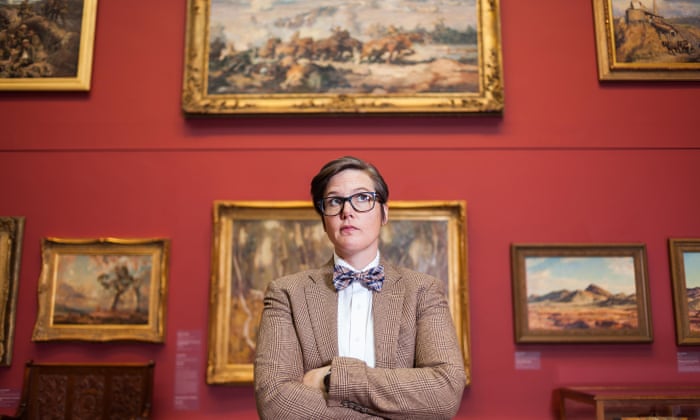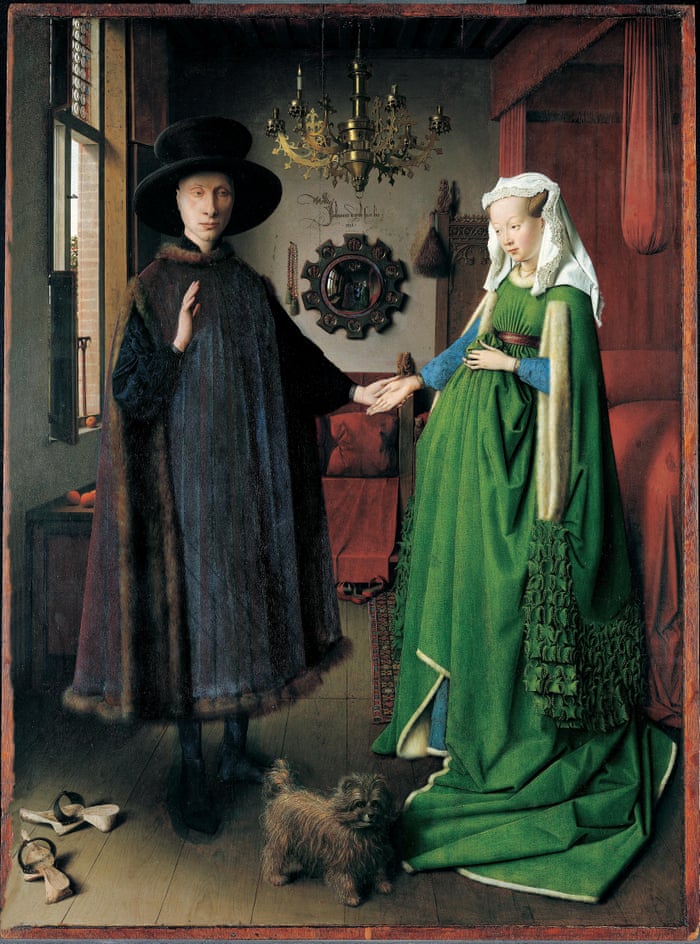
One of my favourite paintings in the world is the small and sombre Arnolfini Portrait painted by Jan van Eyck in 1432.
Rich with detail, it is a wonderful early example of the Northern Renaissance artists’ mastery of oil painting and their obsession with the behaviour of domesticated fabric. But while it may look like a straightforward double portrait, the Arnolfini is one of western art history’s greatest riddles.
Two figures stand in a small room with a bed and a window. They pose formally, and even by painting standards they are very still. On the left, a man stares ahead, wearing a weighty coat and a hat that somehow manages to look serious at the same time as it looks like something that one of the Mario brothers might use to power up. While I will point out here that he looks uncannily like Vladimir Putin in fancy dress, I would urge you to forget that, because it will ruin the painting for you.
 |
| The Arnolfini Portrait by Jan van Eyck, 1434. Photograph: Thames & Hudson |
With one hand he gives a lazy wave in our general direction and with the other he holds the hand of the woman standing at his side, as if he is about to read her palm. Her hand is limp and her gaze is downcast. She shouldn’t be sad, however, because she is wearing a lovely green dress and is sporting a hairdo that involves horns.
The Arnolfini Portrait is one of those paintings that everyone swears they’ve never seen nor heard of until they see it. “Oh! That one!” they always say. “The one with the pregnant lady wearing that heavy green dress!” They are right about one thing: the dress looks equal to the task of curtaining a large bay window. But they are wrong to assume the woman is pregnant.
Not only did Van Eyck have a habit of painting women to look like they were with child even when they were without, but it was also fashionable at the time to look pregnant when you were not. Faking the harvest to attract the seed, so to speak. It’s untidy logic but still makes more sense than thigh gap.
Being able to tell people they are wrong was one of the reasons I decided to study art history. But it didn’t take me long to learn that I was not cut out for the art world. I just I didn’t have what it takes to work in a gallery. Not only do I not wear scarves, chunky jewellery or sport a severe fringe, but my language is too direct and I can’t quite take myself that seriously. But my biggest problems are that I like stories more than facts and a joke more than verisimilitude and that the word “verisimilitude” makes me think of a Disney witch.
One of the champions of art history is Erwin Panofsky and his greatest contribution to the field is his analysis of the Arnolfini Portrait in 1934.
Panofsky argued, very persuasively, that this portrait was not just a work of art, it was also a legal document – the wedding certificate, as it were, of the couple in the painting: Italian cloth merchant, Giovanni Arnolfini, and his wife Giovanna Cenami. Panofsky then showed how every detail of the painting supported his thesis: the small round mirror (God’s all-seeing eye); the small dog at the couple’s feet (“fido” for “fidelity”); the shoes that the couple have taken off (indicating they are in a sacred space and God had just mop-eth the floor); the oranges on the windowsill (you can’t get pregnant if you have scurvy).
Panofsky did such a thorough job and with it he ushered in a new era of art history. He suggested the world was both knowable and solvable. But here’s the snag: in 1990 a document came to light that certified the wedding of Giovanni Arnolfini and Giovanna Cenami occurred in 1447, 13 years after the portrait was painted and six years after the artist had died.
Panofsky’s once-robust theory began to unravel like a ball of string surrounded by a litter of kittens with opposable thumbs. Since then, nobody has been able to come up with a satisfying reading of this painting.
I felt quite sad and foolish when I first found out that Panofsky’s knowable little world had fallen apart. But eventually, I was relieved. Art history has moved beyond the reach of Panofsky. A man of his time, he approached art from a fixed perspective – one that was only ever accessible to the white European elite of the male variety. To assume that a work of art has singular meaning is as arrogant as assuming that every person experiences the world in the same way as you.
I was relieved in the same way I was when I first found out about the Santa Claus conspiracy. Finally, I was able to understand why some kids could starve to death and why I never got a bike. Yes, I just used the tragedy of famine to set up a joke. And that is why I am a comedian, not an art historian.
Niciun comentariu:
Trimiteți un comentariu